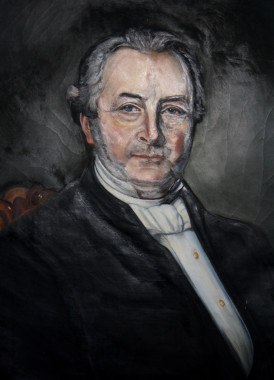Rebellions.12.jpg

Portrait of Philip Henry Moore, c.1860.
Oil on Canvas / Artist unknown.
The Hon. Philip Henry Moore (1799-1880) was one of the leaders of the volunteer militia during the December 7, 1837 raid. Upon hearing the Patriotes advance, Moore cried out, "Come on boys", and led the charge against them.
Moore was born in Rhinebeck, New York, in 1799. In 1802, his family moved to Quebec and established a homestead at the small community of Moore's Corners (St. Armand West). Moore began his career as a farmer at Moore's Corners and as a merchant in Bedford. In 1829, he was appointed Commissioner for the Trial of Small Causes in the Seigneury of St. Armand, and in 1830, Registrar of Missisquoi County.
At the Union of the Provinces in 1841, Moore was appointed Legislative Councillor of Canada, an office he held until Confederation in 1867. His accomplishments during those years included serving as chair of the Rebellion Losses Committee and securing the Charter for the Montreal and Vermont Junction Railway. Th
Oil on Canvas / Artist unknown.
The Hon. Philip Henry Moore (1799-1880) was one of the leaders of the volunteer militia during the December 7, 1837 raid. Upon hearing the Patriotes advance, Moore cried out, "Come on boys", and led the charge against them.
Moore was born in Rhinebeck, New York, in 1799. In 1802, his family moved to Quebec and established a homestead at the small community of Moore's Corners (St. Armand West). Moore began his career as a farmer at Moore's Corners and as a merchant in Bedford. In 1829, he was appointed Commissioner for the Trial of Small Causes in the Seigneury of St. Armand, and in 1830, Registrar of Missisquoi County.
At the Union of the Provinces in 1841, Moore was appointed Legislative Councillor of Canada, an office he held until Confederation in 1867. His accomplishments during those years included serving as chair of the Rebellion Losses Committee and securing the Charter for the Montreal and Vermont Junction Railway. Th